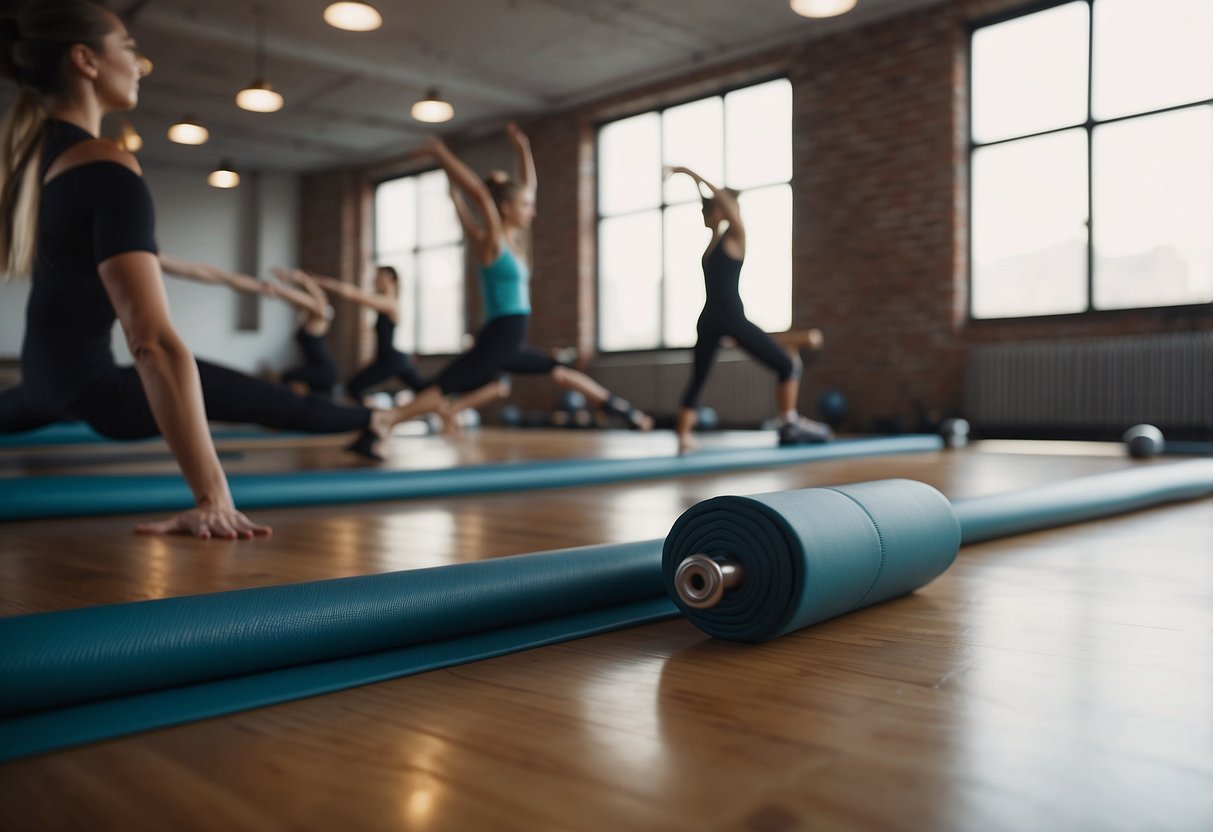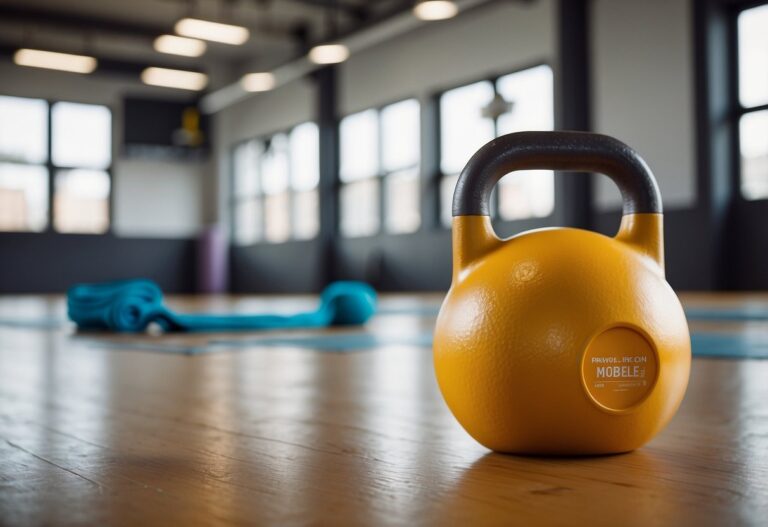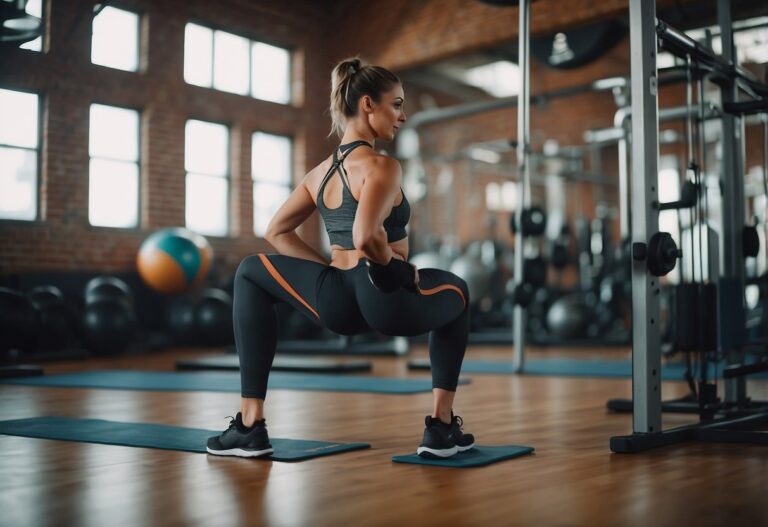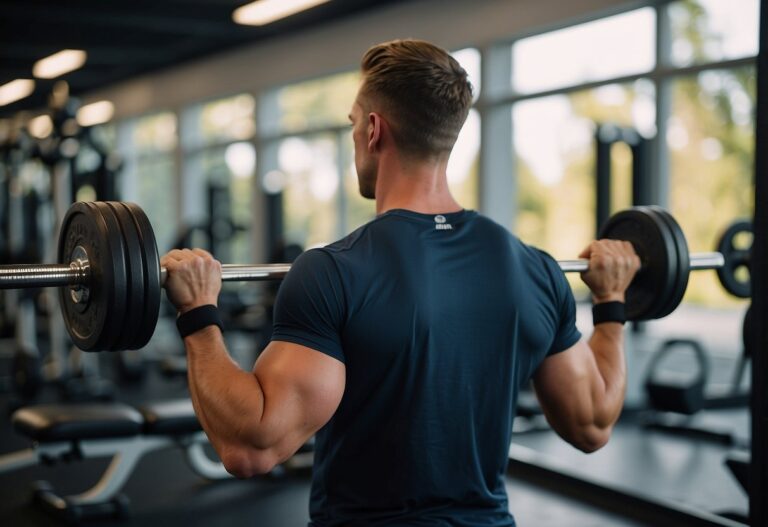If you’re looking to add a new dimension to your fitness routine, barre workouts might be just what you need. These exercises combine elements of ballet, Pilates, and yoga, creating a full-body workout that improves strength, flexibility, and posture. They are designed to be low-impact, making them suitable for people of all fitness levels. Barre workouts can help you develop a strong core and lean muscles, all while enjoying a fun and engaging exercise format.

Starting with barre might seem a bit daunting, but it doesn’t have to be. With some practical tips, you can feel comfortable and confident in no time. It’s all about getting the basics right and focusing on your form. Plus, with so many resources and classes available, you’ll find plenty of support as you begin your barre journey.
Maintain Correct Posture
Proper posture is key when doing barre workouts. It helps prevent injuries and maximises the effectiveness of each exercise.
Keep your shoulders relaxed and down. Avoid hunching or tensing them up. This ensures that you’re using the right muscles and not putting unnecessary strain on your neck and shoulders.
Align your spine. Imagine a straight line from the top of your head to your tailbone. This helps maintain a strong and stable core, essential for support during your workout.
Engage your core muscles. Keeping your abs tight will not only protect your back but also improve your balance. This is crucial for achieving the correct form in each movement.
Engage Your Core Muscles
When you’re doing a barre workout, engaging your core muscles is key. You want to make sure your core is always active to protect your lower back. Start by drawing your belly button towards your spine and keep those muscles tight.
Think about controlling your breath. Avoid sucking in your belly; instead, focus on tightening your abdominal muscles. This helps improve your posture and reduces the risk of back pain.
Using your core muscles correctly makes your workout more effective. Keep your abdominal muscles engaged no matter the exercise, whether you’re standing, kneeling, or lying down.
Practice makes perfect. When you are consistent, you’ll find it easier to engage your core automatically during your workouts. This will enhance your overall strength and stability.
Focus on Small Movements

In a barre workout, focusing on small, precise movements is key. These movements help build strength and muscle endurance.
When you perform these tiny motions, you engage your muscles more effectively. Keep your shoulders down and your core engaged. This ensures proper form and maximises the benefits.
Try using props like resistance bands or light weights. They can help increase the intensity without compromising on the small, controlled movements. You don’t need a lot of space—working out in a small, quiet area at home is perfectly fine.
Remember, the goal is precision, not speed.
Use Light Weights for Resistance
Using light weights in your barre workout can make a big difference. Start with light weights between 1-5 pounds. This helps you build muscle without risking injury.
Focusing on proper form is key. Keep your core engaged and use slow, controlled movements. This not only prevents injury but also allows you to get the most out of each exercise.
If you’re working out at home and don’t have weights, you can use items like water bottles or cans. This adds versatility to your workout routine and ensures you never miss a session.
Incorporate light weights into various exercises, like bicep curls or shoulder presses, to target different muscle groups. This helps in building overall strength and balancing muscle tone.
Try a full-body barre workout that includes weights for a comprehensive routine. For example, you can follow a 45-minute barre workout that uses light weights and resistance bands for enhanced intensity.
Wear Proper Athletic Apparel
When heading to a barre class, comfort and flexibility are key. Opt for form-fitting workout clothes like leggings or capris. These help the instructor see your body alignment better, ensuring you perform movements correctly.
A fitted tank top or sports bra is ideal to keep you comfortable and prevent restricted movement. Studios can be cold initially, so bring a long-sleeve shirt for the start of your session.
Consider layering your clothing. As the workout progresses and you warm up, you can easily peel off layers to stay comfortable. Plus, wearing moisture-wicking materials will help keep you dry and comfortable throughout the session.
Hydrate Before and After Workout

Staying hydrated before and after your barre workout is crucial. Drinking water helps your body function properly and keeps your muscles working well.
Before you start, aim to drink 16 to 24 ounces of water about two hours before your workout. This helps prep your body and ensures you’re not starting on a deficit. Then, have another 8 ounces 15 minutes before you hit the barre.
During the workout, keep sipping water. Drink 16 to 32 ounces every 30 to 60 minutes. This keeps your energy levels up and helps prevent dehydration which can make you feel tired quickly.
After exercising, drinking water helps to flush out your system and refuel. You might also want to add an electrolyte drink if you had a particularly sweaty session. This can help replenish lost minerals and keep you feeling great.
Hydration isn’t just about water. Consuming nutrient-rich fluids like juice or milk can also help. Check out more detailed information on hydration practices to tailor your intake based on your needs.
Remember, being well-hydrated helps your performance and recovery, making your workouts more enjoyable and effective.
Incorporate Stretching
Stretching is essential in a barre workout.
Take time to stretch all major muscle groups. Hold each stretch for at least 30 seconds. This can help improve flexibility and range of motion. It’s especially helpful if you have tight muscles.
You can follow a stretching sequence after your barre session. Start with gentle stretches, then move to more intense ones. Use a chair or a barre for support if needed.
Remember to breathe deeply while stretching. It helps relax your muscles and increase blood flow. Regular stretching can help you feel better and reduce the risk of injury.
Gradually Increase Intensity

When starting your barre workouts, it’s important to take things slow. Begin with a few sessions each week. This gives your body time to adjust to the new movements and prevent injuries.
As you become more comfortable, try adding more days into your routine. You can start with two or three sessions per week and then move up to four or five as your strength builds.
Listen to your body. If a movement feels too challenging, modify it or take a break. Pushing yourself too hard too quickly can lead to setbacks.
Using light weights or resistance bands can help increase the challenge. Incorporate these tools slowly, ensuring you maintain proper form to avoid injury.
Listen to Your Body
When doing a barre workout, it’s crucial to listen to your body. Don’t push yourself too hard. Pay attention to any signals your body sends you, such as pain or discomfort.
If you feel unusually tired, take a break. Remember, progress is about consistency, not overexertion.
Consider using props like a chair for balance. These help maintain proper form and prevent injuries.
Always focus on proper alignment. This ensures that you’re targeting the right muscles and not straining others.
Tip: Track Your Progress
Think about keeping a workout journal. Write down how you feel before, during, and after your workouts. This can help you notice patterns and make adjustments.
Taking care of your body is the key to long-term success and enjoyment in any exercise routine. Make sure you listen to it every step of the way.
For more on detailed advice and techniques, you may find helpful tips at Tone And Strengthen Your Muscles Gracefully.
Use a Mirror for Form Checks
Using a mirror during your barre workout helps you maintain proper form. It lets you see if your body aligns correctly, which prevents injuries and ensures maximum benefit.
Place the mirror where it’s easy to glance at without straining your neck. If your alignment is off, adjust your position right away.
Remember to keep your shoulders relaxed and your spine neutral. Mirrors also help you notice smaller details, like hand positioning and foot placement.
When you can’t use a mirror, try using your phone to record yourself. Watching the footage can give you similar feedback.
Benefits of Barre Workouts
Barre workouts offer a range of benefits that not only improve physical fitness but also enhance mental well-being. These workouts focus on small, controlled movements that target various muscle groups, helping you achieve a lean and toned physique.
Improved Flexibility
One of the key benefits of barre workouts is improved flexibility. Many of the exercises involve stretching and lengthening your muscles. You will often perform moves similar to those in ballet, such as leg lifts and stretches. Incorporating these into your routine can help increase your range of motion.
Flexibility is essential because it allows you to move more freely and reduces the risk of injury. Also, improved flexibility can ease muscle tension and help you feel more relaxed. Classes often end with a stretching session to ensure your muscles remain supple and flexible.
Enhanced Muscle Tone
Barre workouts are excellent for enhancing muscle tone. The exercises target muscles in your arms, legs, and core through high-repetition, low-impact movements. Using light weights, resistance bands, and exercise balls, you can sculpt and define your muscles.
You will notice increased muscle endurance, which means your muscles can work longer without getting tired. These workouts help build lean muscle mass, giving your body a more toned appearance. Additionally, the repetitive movements strengthen your muscles over time, leading to better overall muscle tone.
Better Posture
Better posture is another significant benefit of barre workouts. Many of the exercises focus on strengthening the muscles in your back, shoulders, and core. These muscles are crucial for maintaining good posture and supporting your spine.
Good posture not only helps you look more confident and poised but also reduces strain on your muscles and joints. By regularly participating in barre workouts, you will become more aware of your body alignment. This awareness helps you make adjustments, both during the class and in everyday activities, leading to improved posture and reduced back pain.
Common Barre Exercises
Barre workouts are known for their ability to tone muscles and improve flexibility. Here are three essential moves: pliés, tendus, and relevés, each offering unique benefits for your fitness routine.
Pliés
Pliés are a fundamental barre exercise inspired by ballet movements. To perform a plié, start with your feet turned out and shoulder-width apart. Lower yourself by bending your knees, keeping your back straight and your core engaged. This move primarily targets your thighs and glutes.
A key tip is to keep your heels on the ground during the descent, ensuring that your knees are aligned with your toes. Common Mistakes to avoid include letting your knees go inward or leaning your torso forward. Regular practice of pliés can enhance your lower body strength and improve your posture.
Incorporate variations like grande pliés (deeper bends) to challenge your muscles further. This exercise is great for anyone looking to develop strength and flexibility in their legs.
Tendu
The tendu is another ballet-inspired move that works wonders for your footwork and leg muscles. Stand tall with your feet in the first position (heels touching, toes turned out). Extend one leg out straight, keeping it pointed, and touch the floor with your toe, then bring it back to the starting position.
Focus on maintaining a strong, stable core throughout the movement. This move sharpens your balance and strengthens the muscles in your feet, calves, and thighs. It also enhances your coordination and flexibility.
Perform several repetitions on each leg to get the full benefit. Be mindful to avoid lifting your hip as you extend your leg, which can throw off your alignment. Tendus are perfect for refining your mobility and precision in movements.
Relevé
Relevés work the calves and the entire lower body. Begin in either first position or with your feet hip-width apart. Lift your heels to rise onto the balls of your feet, engaging your core for balance, then lower back down steadily.
This move not only tones your calves but also helps with balance and stability. It’s essential to keep your knees straight but not locked, and distribute your weight evenly across the balls of your feet. Relevés are particularly beneficial for runners, as they strengthen the muscles around the ankles and calves, improving running efficiency.
Tips: Practise holding the top position for a few seconds to build endurance. Avoid rolling your ankles inward or outward to prevent injury and ensure proper form. Regularly incorporating relevés into your routine can lead to stronger, more stable lower legs.
Tips for Beginners
When you’re new to barre workouts, it’s important to focus on the essentials. You’ll see the best results by concentrating on proper form, starting off slow, and understanding your body’s limits.
Focus on Form
Proper form is key to getting the most out of your barre workout. Keeping your back straight and engaging your core helps prevent injuries. Pay attention to your instructor’s cues and don’t hesitate to ask for corrections.
Using a mirror can help you ensure that you’re aligned correctly. Barre workouts often target smaller muscle groups that you might not typically engage. This means that even slight misalignments can hinder your effectiveness and increase the risk of strain.
Small movements make a big difference. It’s common in barre to perform tiny, controlled motions. This technique is effective but only if your form is perfect. Avoid large, sweeping motions unless specifically directed by your instructor.
Start Slow
It’s tempting to jump into a rigorous routine, but starting slow is the best approach. Aim to begin with one to two classes a week. As you gain confidence and strength, you can gradually increase the number of sessions.
Your body needs time to adapt to the new movements and to build the necessary muscle endurance. Overworking yourself early on can lead to fatigue or injury, derailing your progress. Allow each muscle group time to recover between classes.
By pacing yourself, you not only build a solid foundation but also prevent burnout. This approach ensures that you remain motivated and look forward to each session, which is critical for maintaining a long-term fitness routine.
Listen to Your Body
Your body will communicate how it’s responding to the workout. Pay close attention to signs of fatigue, discomfort, or pain. It’s important to differentiate between normal muscle fatigue and pain that indicates injury.
If something doesn’t feel right, stop and evaluate. Modify exercises when needed and never push through sharp pain. Using props like rubber balls, small weights, or yoga balls can help tailor movements to your comfort level.
Rest is as important as exercise. Adequate recovery allows your muscles to repair and strengthen. Combine your barre routine with other low-impact activities like walking or swimming to keep your fitness regimen balanced and enjoyable.
Integrating Barre into Your Fitness Routine
Barre workouts are a versatile addition to your fitness regimen. They help improve strength, flexibility, and coordination, and can be tailored to suit any fitness level.
Frequency of Barre Workouts
When starting with barre, aim for three sessions per week. This frequency allows your muscles to adapt without overtraining. Barre can be intense, engaging smaller muscle groups you might not typically work.
As you progress, you can increase the frequency to four or five times a week if your body feels ready. Listen to your body to avoid injuries. Consistency is key; regular barre practice enhances muscle tone and flexibility over time.
Incorporate variety to keep things interesting. Try different barre classes or online tutorials. Scheduling your workouts can also help maintain your commitment.
Combining with Other Exercises
Barre pairs well with other forms of exercise to create a balanced fitness routine. Adding cardio workouts such as running or cycling can improve your endurance and burn more calories. On the other hand, strength training can build muscle mass that complements the toning effects of barre.
Yoga is a great companion to barre, enhancing your flexibility and mental focus. High-Intensity Interval Training (HIIT) can add intensity and offer cardiovascular benefits.
Mixing barre with various exercises can prevent workout monotony and enhance your overall fitness. Consider structuring your week like this:
- Monday: Barre
- Tuesday: Cardio
- Wednesday: Strength Training
- Thursday: Barre
- Friday: Yoga
- Saturday: HIIT
- Sunday: Rest or Light Activity
Combining these routines ensures a holistic approach to fitness, keeping your workouts diverse and effective.







